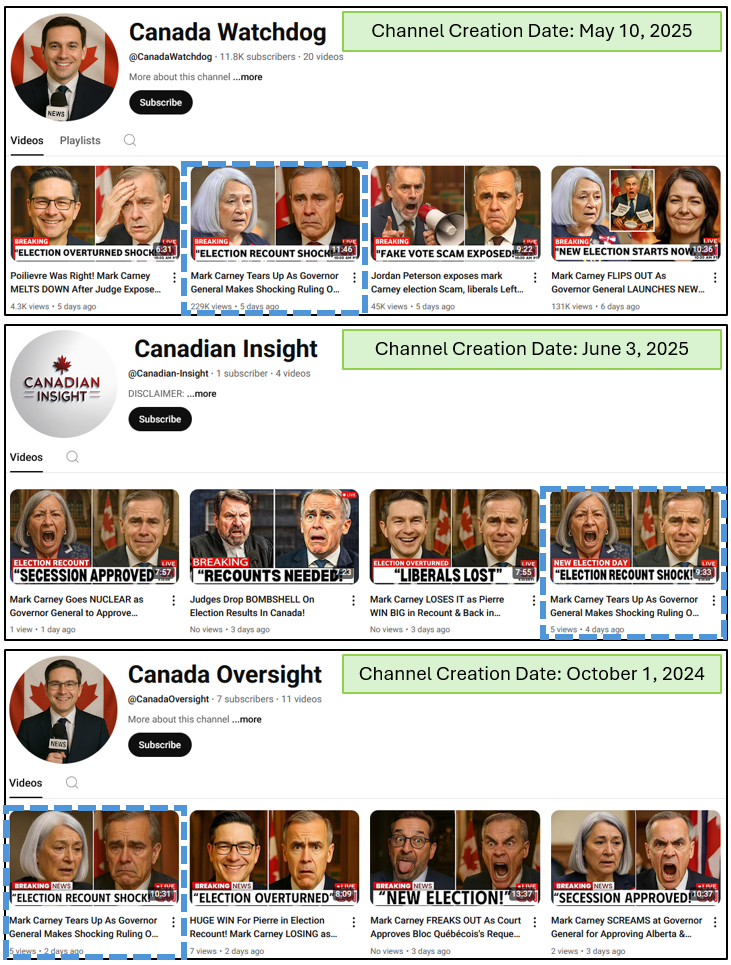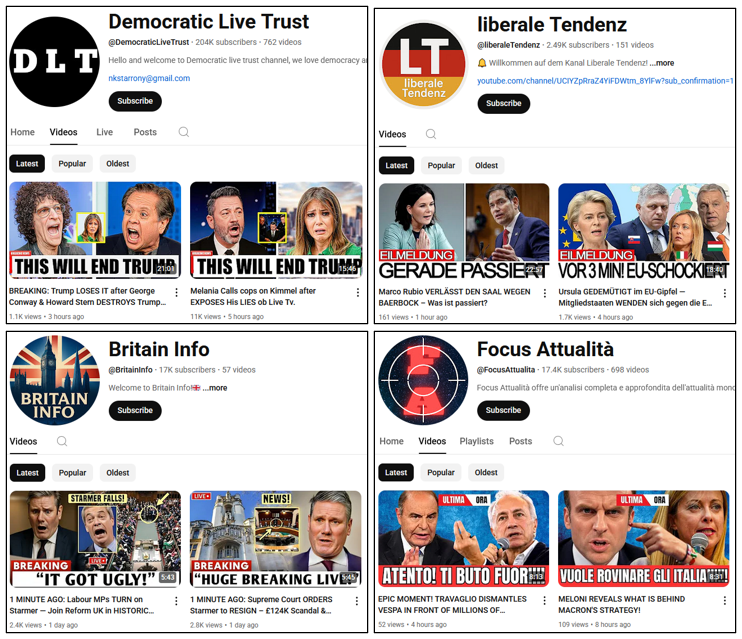AI-generated news channels spread election fraud and separatist narratives in Canada
Highly partisan AI-generated news reached millions before being removed by YouTube
AI-generated news channels spread election fraud and separatist narratives in Canada

BANNER: Screenshots of a sample of twelve AI-generated Canadian news channels on YouTube active on June 13, 2025. Many of the channels have since been suspended. (Source: YouTube)
AI-generated videos on YouTube promoted misleading political content targeting Canadian audiences, sharing narratives about election fraud, political corruption, and Alberta separatism. During the course of this investigation, YouTube suspended most of the identified AI-generated news channels targeting Canada and announced new measures to protect against content such as this, sometimes referred to as AI slop. Despite efforts to rein in the content, the videos had already amassed more than five million views before removal and were shared across Facebook groups, demonstrating how low-effort, AI-generated content can quickly exploit platform algorithms and audience engagement to achieve significant reach.

Canada’s Liberal Party, under the leadership of Mark Carney, won a minority government in the April 28 federal election. This was a reversal in expected outcomes as the opposition Conservative Party had been leading the polls during Justin Trudeau’s tenure as Liberal Party leader. The Canadian election is largely considered to have been well-defended against attempts at interference. Still, the vote was not immune to such activity and illustrated many of the common digital threats to election integrity. For example, shortly after the vote, select electoral ridings, such as Milton-East Halton Hills-South, had races that were too close to call. As the Liberal Party was nearing the 172 seats needed to form a majority government, these close electoral ridings could have shifted the balance of power in Canada, a circumstance that prompted conspiratorial claims to circulate online. Additionally, unfounded accusations of electoral fraud circulated during the election, including false viral claims suggesting that poll workers took ballot boxes home.
The issue of Alberta’s separation from Canada emerged as a contentious topic during the election cycle. Alberta separatism, though traditionally a less mainstream political ideology, gained more prominence during the recent election cycle. Supporters of the movement often cite a belief that the federal government in Ottawa is not sufficiently addressing Alberta’s concerns. A 2025 poll from the Angus Reid Institute found that at least 36 percent of Albertans were leaning towards leaving Canada. According to Google Trends, searches for “Alberta separatism” and “Alberta independence” peaked between April 27 and May 3, amid the election. Growing interest in the Alberta separatist movement created an online demand that was quickly exploited by individuals producing low-quality, AI-generated content and uploading it to YouTube.
AI slop is a term that describes mass-produced, low-effort, and misleading AI-generated content, often perceived as spam. This type of content, which can take the form of video, image, audio, or text, spreads across various online spaces and social media platforms, creating significant noise. Recently, AI-generated content on YouTube gained significant attention in popular media, particularly after John Oliver’s Last Week Tonight broadcast a segment on AI slop. Additionally, popular influencer Mr. Beast recently received backlash for promoting his Viewstats platform, which generates YouTube thumbnails using AI software, prompting him to remove the AI-generated service. However, there are still many similar services available, such as VEED.io, which rely on AI to generate video elements, including vital components such as the script. This has led to the mass creation of faceless, AI-generated YouTube channels, which enable creators to monetize low-effort content. One harmful consequence of this behavior is the impact on news sources, as both emerging and ongoing political issues attract the attention of AI slop creators.
AI-generated channels imitate Canadian news outlets
The DFRLab identified forty-two AI-generated YouTube channels posing as Canadian news sources. The AI slop videos populating these channels are characterized by low production value and poor quality control. The DFRLab performed topic modeling using BERTopic on 771 Canada-related videos, determined by their titles. The results showed that the key topics of focus for the channels were: surging support for Pierre Poilievre, the separatist movement in Western Canada, and Alberta Premier Danielle Smith’s stance against the federal government. Using BERTopic, the videos were sorted into different mutually exclusive categories (see image below). Overall, however, much of the content across the categories focused on the electoral recount, which appeared to be the most recurring subject throughout the footage. For example, two videos (“Pierre WINS Big in Recount & RETURNS to House of Commons After RECOUNT! Liberals FUME!” and “Mark Carney MELTS DOWN as Pierre Poilievre WINS Recount — Liberals in Absolute PANIC!”) were sorted in different topics because they framed the same narrative from different perspectives, but ultimately referenced the same broader issue.
Chart shows common AI-generated Canada-related news topics, categorized based on video title. The DFRLab assigned topic names to each category and made slight manual adjustments to some categorizations. (Source: DFRLab)
The AI-generated videos reference the electoral recount with overt bias and promote various false claims. Twenty-three videos cast doubt on the electoral process, primarily in Halton Hills and Vancouver South. Some of the doubts about the electoral process may have been derived from AI hallucinations. For example, videos falsely claimed an unexplained surge in advanced polling for the Liberal Party in Halton Hills, but Elections Canada did not publish advanced votes by party. In seventeen videos, suspicions were raised about Vancouver South, with claims of either missing ballots or more ballots than registered voters. However, “Vancouver South” was no longer a federal election district for the 2025 election as it was renamed to “Vancouver Fraserview—South Burnaby.” In this newly drawn riding, the DFRLab found no reports from authoritative news sources or social media accounts regarding electoral process issues. It is possible that the AI used to generate the script fabricated this incident.
The DFRLab, utilizing Google Gemini AI software, collected video transcripts and extracted phrases that mention the three most frequently referenced political leaders: Carney, Poilievre, and Smith. A comparison was then run on the sentences with sentiment anchor sentences, such as “their track record shows consistent delivery on campaign promises,” to calculate a positive and negative score using their embeddings. The resulting sentiment distribution is plotted in the graph below. It shows that Carney is depicted less favorably than Poilievre and Smith. This analysis indicates a degree of bias favoring the Conservative Party in the examined AI-generated videos.
The sentiment distribution of phrases in AI-generated scripts mentioning Canadian politicians. This graph is an approximate representation of sentiment and should not be considered an exact measure. (Source: DFRLab)
There appears to be a degree of coordination among these channels, as evidenced by the same title or script being used by different channels. For example, three videos titled “Mark Carney Tears Up As Governor General Makes Shocking Ruling On Election Results” were uploaded by three different channels within a few days. They all feature the same underlying script, just with slightly modified word choices. The most viewed of these videos received 220,000 views.

AI slop spreads
Beyond Canada, AI-generated news channels are targeting many other countries, including the United States, the United Kingdom, Germany, and Italy. Channel owners are incentivized to create videos targeting Western audiences, as they are believed to generate higher ad revenue on YouTube.

In terms of AI policy, YouTube encourages the use of innovative tools for video production, including AI. It states that creators do not need to disclose the use of AI for production assistance, “like using generative AI tools to create or improve a video outline, script, thumbnail, title, or infographic.” However, AI is being used to an even greater degree as tools enable the production of videos with near-zero human input and creativity, allowing AI news channels to proliferate and spread partisan narratives. YouTube announced that it will update its partner guidelines to “better identify mass-produced and repetitious content” starting on July 15. YouTube has not specifically outlined its policy on videos in which one of the most valuable parts of the content—the narrated news script—is entirely AI-generated. However, it appears that low-effort AI slop creators will find it harder to monetize their content on YouTube.
Cite this case study:
DFRLab, “AI-Generated News Channels Spread Election Fraud and Separatist Narratives in Canada,” Digital Forensic Research Lab (DFRLab), July 17, 2025, https://dfrlab.org/2025/07/14/ai-generated-news-channels-spread-election-fraud-and-separatist-narratives-in-canada/.

